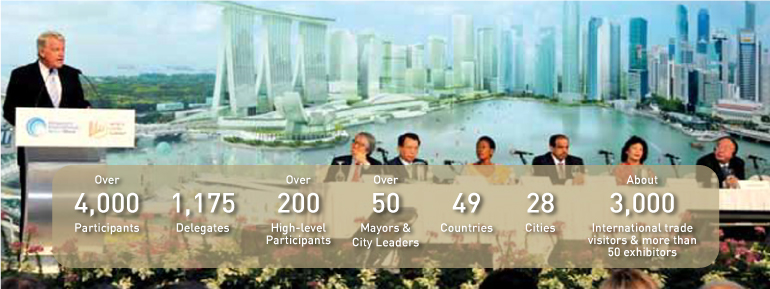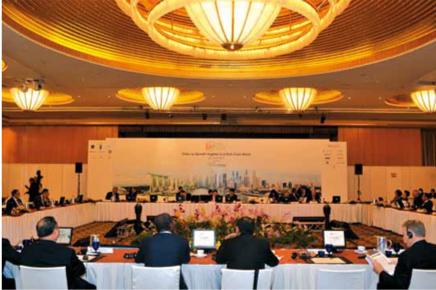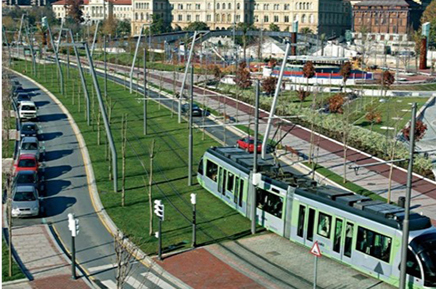Home >
ABOUT US >
Past Editions >
World Cities Summit 2010
World Cities Summit 2010

Themed “Liveable and Sustainable Cities for the Future”, the 2nd World Cities Summit (WCS) was held in Singapore from 28 June to 1 July 2010. Delegates discussed experiences and challenges faced during the 2009 global financial crisis, and how best to manage the growth of cities in a way that can meet the aspirations of the people and yet is sustainable to the shared environment.
The Summit was co-located with the Singapore International Water Week and the World Urban Transport Leaders Summit to reap synergistic benefits. The WCS Expo—held in an area four times larger than in 2008— showcased the latest model cities and innovative urban solutions that enhance economic value while addressing environmental challenges.
Complementing the plenary and dialogue sessions were a series of six expert panel sessions offering deep dives into Planning for a World-Class City, Maintaining a Competitive Economy, Shaping the Liveable Environment, Working Towards Environmentally Sustainable Cities, Balancing Resource Conflicts and Competing Demands, and Enhancing Biodiversity.
MAYORS FORUM

More than 50 governors, mayors and experts attending the WCS Mayors Forum 2010 deliberated on the challenges of enabling progress and ensuring quality living in high-density cities at a time when the proportion of the world’s population living in cities is set to reach 75% in the next 30 to 40 years from the current 50%.
The Forum noted that it is imperative that urban planners, transport planners and local populations work hand in hand to lead change in the right direction, underpinned by three core conditions: leadership, courage and dialogue. Key takeaways:
- Leadership: Commanding the vision to drive change even through challenging times, as demonstrated by the Saudi Arabian city of Al Madinah Al Munawarah’s Observatory System to collect data to track its Millennium Development goals; Lagos’s success in improving the city’s image through infrastructure renewal and development; citizen-centric information management by Tangshan, China, to capitalise on its strengths and quicken its pace towards becoming a scientific city.
- Courage: It takes the form of pursuing eco-friendly and liveable communities in partnership with an active corporate and civil citizenry even if results take time to manifest.
- Dialogue: Keep promoting Communities of Best Practices among cities. Global platforms like the WCS Mayors Forum could provide opportunities for the development of a peer-to-peer learning network.
LEE KUAN YEW WORLD CITY PRIZE
LAUREATE CITY: BILBAO

The inaugural Lee Kuan Yew World City Prize was conferred on Bilbao City Hall in recognition of its integrated and holistic approach towards urban transformation. Bilbao City Hall has been instrumental in regenerating and transforming the Spanish city from an obsolete and dilapidated industrial city into a knowledge-based economy.
The success of Bilbao is largely attributed to its integrated and holistic approach to achieve economic, social and physical transformations. Its emphasis on environmental clean-up, use of culture, internationalisation and design, major improvements to its infrastructure, as well as the restoration of its historic areas over some 25 years have successfully rejuvenated the city. More significantly, the city was able to connect investment in infrastructure with social integration. The river, which was once a physical and social barrier, is now a hub for social and cultural integration and a centre for innovation and creativity.
EXPERT PANEL SESSIONS
Session 1: Planning for a World-Class City
The session comprised three tracks focusing on strategies for making cities sustainable and endearing, driving growth, and on how Southeast Asian cities can adapt to globalisation.
Key insights:
- Making Cities Sustainable and Endearing: Strategies for Success
People-oriented cities are sustainable cities. Truly liveable cities should be designed with a quality environment and with the pedestrian in mind. A comprehensive approach towards planning includes social and environmental factors. In city building, the public sector remit is not to build afresh but to intervene within the fabric and work with existing structures.
- Pathways to Growth: Analysis from the Global Liveable Cities Index
The track discussed The Global Liveable Cities Index (GLCI) commissioned by the Centre for Liveable Cities (CLC) in 2008 with the objective of developing a balanced assessment of urban liveability. Participants concluded that the GLCI’s focus on the needs of the local population renders it useful in helping urban policymakers identify areas of improvement.
- Cities in Southeast Asia: Opportunities and Challenges in the Age of Globalisation
Thailand, Indonesia and Malaysia shared their experiences and perspectives on managing the impact of urbanisation and responding to emerging challenges. Discussions focused on the need to create inclusive social policies to help the urban poor. The main priorities of larger cities like Bangkok and Jakarta are to respond to the impact of rapid urbanisation and global warming through urban policies and projects. In Kuching North, partnerships with the private sector and mutually beneficial networks with cities and towns in the surrounding areas also boost the city’s attractiveness, liveability and appeal to the business community.
Session 2: Maintaining a Competitive Economy
Two tracks examined financing municipal infrastructure and the role of innovation and industry in creating sustainable urban solutions.
Key insights:
- Financing of Municipal Infrastructure
Jointly organised by the CLC and the World Bank, the panel explored challenges that cities in emerging markets and developed economies face in raising private capital for public infrastructure. The discussion concluded that while solutions hinge on public-private-civil society partnerships, governments must not entirely outsource projects to the private sector as the city lives with the outcome for the next 15–20 years. Public agencies that work with private investors need to have a credit culture ingrained in their operations in order to be credible partners.
- Sustainable Urban Solutions: Role of Innovation and Industry
This session emphasised that with innovation, the private sector and governments could harness resources efficiently by devising novel market-oriented sustainable solutions such as those witnessed in areas like urban infrastructure, transportation, energy security, information and communication technologies, traffic management and connectivity. In an inter-connected environment, it is essential to foster consensus among various actors and decision-makers.
Session 3: Shaping a Liveable Environment
Two thematic tracks focused on built environments and living environments.
Key insights:
- Shaping World-Class Built Environments
Shaping world-class built environments involves taking a long-term view of sustainability while preserving the uniqueness of cities’ urban design, history, heritage and culture. The quality of a built environment hinges on the effectiveness of the local building control regime which in turn defines liveability of a city. Growing cities must address the needs of changing demographics, while ensuring that the built environment is safe, well-maintained and carbon-constrained. Future-proofing the sustainability of built environments requires collaborative effort between the public and private sectors.
- Beyond Affordable and Quality Housing: Gracious and Harmonious Living Environments
Many countries and cities have progressed from the building of basic shelters to the provision of quality housing. Engaging communities to shape their living environments and build local identities requires strategies to promote social cohesion, whilst encouraging gracious living. Successful public housing is no longer solely about quality and affordability.
Governments need to place greater emphasis on community engagement and environmental sustainability as well.
Session 4: Working Towards Environmentally Sustainable Cities
Three thematic tracks explored issues of climate change, waste management, and overcoming roadblocks to realising city plans and projects.
Key insights:
- Cities and Climate Change
Urban growth exerts great pressure on energy and water resources, particularly in megacities of 10 million or more people. To tackle the challenges of climate change from various angles, city planners need to understand the way cities function. They need to develop growth models that moderate energy use, minimise waste and increase efficiency. Promoting Walkability and building “Smart Cities” were among the solutions proposed.
- Sustainable Waste Management—Turning Trash into Resource
Rapid urbanisation and crowded cities lead to the proliferation of solid waste. Ineffective waste management could weigh on the infrastructure, especially in developing countries. Cities have to reinforce existing systems and plan for longer-term waste management, resource conservation and environmental sustainability. Individual countries need to identify their own priorities on waste management and recycling. Regional cooperation would enable such implementation to be vitalised.
- Moving Beyond Plans to Implementation
As resources are limited, governments must prioritise projects objectively and holistically. This then becomes the city’s development strategy. Governments must also identify which projects it should fund, and which are more suitable for Public-Private Partnership. Carbon financing and savings from energy efficiency projects are other sources of funds. Finally, capacity building at all levels and the involvement of all key players is important to turn plans into reality.
Session 5: Balancing Resource Conflicts and Competing Demands
- Challenges that Cities Face—Nexus of Energy, Water and Food Security
Concerted joint action among the government, commercial and people sectors at the city, national and regional levels was seen as crucial for bridging the gap between the demand for water, energy and food on the one hand, and supply on the other.
Session 6: Enhancing Cities’ Biodiversity
- Urban Biodiversity and Ecology for Sustainable Cities
In order to improve liveability in high-density environments, cities should make available nature and biodiversity, especially as urbanisation intensifies. An interdisciplinary approach was recommended to solve urban problems and achieve a good balance.